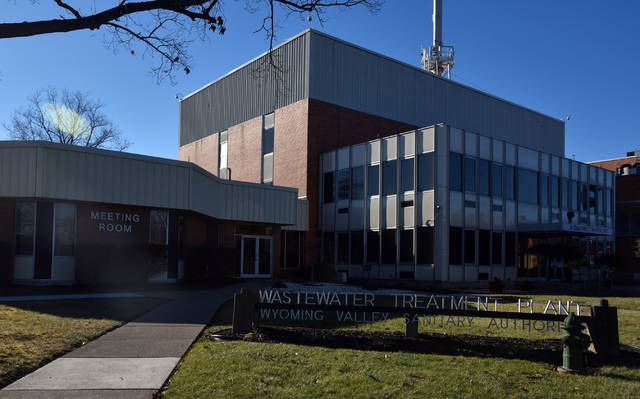Click here to subscribe today or Login.
As complaints about a new stormwater fee persist, the Wyoming Valley Sanitary Authority held an open house Monday to draw attention to pollution reduction work being funded by fee revenue.
Poster boards were set up in a meeting room at the Holiday Inn East Mountain in Plains Township explaining rain gardens, stream restoration and stormwater parks.
The authority also put out reports showing it has replaced 21 catch basins, cleaned 559 basins and swept 1,892 streets to date in most of the 32 municipalities that had signed up for its regional program to comply with a federal mandate to lower sediment, nitrogen and phosphorus in the Susquehanna River and, ultimately, the Chesapeake Bay.
There also were samples of biodegradable pet waste clean-up bags, a rain barrel on display and pamphlets on what property owners can do to reduce pollutants and obtain credits lowering their fee bills.
Fee payers were invited to meet one-on-one with authority representatives to discuss their nonabsorbent impervious area (IA) used as a basis to determine their fee or other concerns.
Authority public relations/regulatory liaison Donna Gillis said a steady stream of business and residential fee payers came seeking further explanation of their bills.
”Some said they understood the calculations a lot better after they talked to our representatives, and they were grateful for a chance to talk,” Gillis said.
Not all attendees were accepting.
Residential fee payer John Newman attended earlier in the day to voice his frustration with the fee, saying he refused to call it anything but a “rain tax.”
Newman predicted the fee will stifle commercial growth and hurt taxpayers who have to pay “now and later” for their own bills and to cover fees owed by their churches, schools, governmental properties and businesses they frequent. He said he won’t be satisfied unless the federal government picks up the tab for its mandate.
Joe Hawk, who is running for Pittston Township supervisor, said he attended to obtain more information about the fee because every resident he met on the campaign trail is upset about it.
Some pollution reduction projects planned, according to the material presented:
• Stream bank restoration
A poster illustrated plantings along a stream bank to reduce erosion and capture pollutants, with a pilot project planned along Spring Run in Hanover Township between West Liberty Street and Solomon Creek.
Restoration is estimated at $325 per foot, and the authority plans to tackle 10,000 feet along various waterways at a total cost of $3.25 million.
• Stormwater park
These cost about $1.33 million each, and three are planned at a total estimated cost of $4 million, it said.
Stormwater parks provide pollutant/sediment filters, recreation space and public education. Sites must be large enough to hold runoff from a sizeable drainage area.
“We want the parks to have a big educational value so people can understand what’s going on and how it works,” authority Executive Director Jim Tomaine has said.
One park is planned in Plains Township. The municipality is willing to provide land, and at least one grant has been received to complete engineering, the authority has said.
• Rain garden
Rain gardens contain depressions planted with specially-selected native vegetation to treat and capture runoff.
Each garden will cost an estimated $30,000, with 25 planned in numerous municipalities at a combined total cost of $750,000, it said.
The first pilot garden is expected to be located at the Wilkes-Barre Area Career and Technical Center in Plains Township, a poster said.
Tomaine has said the authority is working with municipal engineers to find suitable locations, with a target that each garden will treat drainage from at least five acres. All municipalities in the regional plan will share pollution reduction credit from the projects, regardless of their location.
Another open house display said the authority’s regional program is estimated to save the area roughly $274 million over the next 20 years through “economies of scale” and “streamlined regulatory requirements.” The average residential property owner will save 60 percent paying the fee instead of individual municipal compliance plans funded through local real estate taxes, it asserted.





